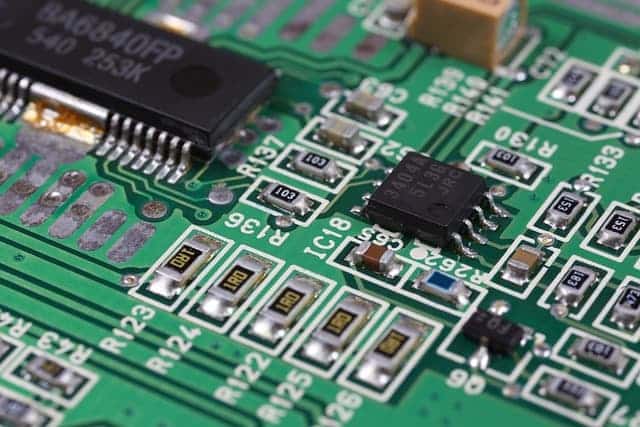Our customers at Rush PCB Inc often use jumpers in their printed circuit board designs. In fact, the use of jumpers starts early, sometimes with the use of breadboards. These are typically double-sided connectors insulated along their length. Engineers use these universal devices frequently to understand the basics of circuit analysis and networking. By plugging in these simple through-hole devices, the conductive wire makes it easier for beginners to understand the marvels of modern electronics. In fact, jumpers provide tactile feedback that the user can compare with toys like building blocks of childhood.
However, jumpers today are not limited to multicolored wires straddling breadboards. There are through-hole jumpers mimicking physical resistors of 0-ohm value. Similarly, there are SMD jumpers, again representing zero-ohm resistors. Where designs cannot use through-hole components, using SMD jumpers is an alternative option. However, SMD jumpers offer additional functionality, other than acting simply like a resistor.

Necessity of SMD Jumpers
It is not easily apparent why designers should use an SMD jumper at all. Explanations for using through-hole jumpers can include flexibility during design iterations, starting from proof-of-concept and proceeding to prototyping. However, designers prefer to move away from through-hole components as the design progresses. Some designers use SMD jumpers to reduce the number of layers. In essence, apart from allowing two tracks cross each other, jumpers also serve other purposes:
- Optional Connection: Jumpers can act as optional connections, especially during development and prototyping. Their presence helps in testing or debugging a specific part of the circuitry. Designers often represent them on a schematic as a 0-ohm resistor, and list them in the BOM as DNI or do not install component.
- Easy Testing: Jumpers can divide entire circuitry into modular blocks, making it easier to test them in isolation or in any combination. This expedites testing and troubleshooting drastically, as it becomes possible to isolate or reintegrate entire circuit blocks by simply desoldering a single junction.
- Toggle Settings: In case of programmable circuit boards such as motherboards, jumpers can act as on-board toggle settings. This may involve toggling between primary and secondary drives, selecting boot settings, etc.
Manufacturers also benefit from the presence of jumpers. For instance, a circuit may require a specific load resistance for testing or calibration. The presence of a jumper eases the selection between the actual load and the specific load resistance. Once the testing or calibration activity is complete, the operator only has to change over the jumper to connect to the actual load.
In specific cases, the jumper may also offer a choice between on/off conditions. It may be necessary for a jumper to connect two or more pins to provide an on condition, while connecting to one or no pins to represent an open or off condition.
Advantages of Through-Hole Jumpers
Though-hole jumpers can offer length, range, and flexibility. This allows them to span long distances on the board. Through-hole jumpers are easier to implement in boards densely packed with components.
Advantages of SMD Jumpers
SMD jumpers are highly versatile, although there is a considerable compromise in their reach as compared to that of through-hole jumpers. This is because of their availability in varied designs. A common SMD style is that of a square arch, with a significant clearance beneath the device. This allows the jumper to straddle copper features on the board without touching pads or components on the top layer under it. Another version of the SMD jumper can carry high currents that would exceed the current-carrying capacity of a common wire jumper. Although requiring the presence of solderable pads for mounting them, SMD jumpers can allow crossing of two same-layer outer signals without resorting to another layer for a transition. Essentially, the jumper can act as an extra trace on the outer top layer of an exceptionally dense board configuration.
SMD Jumpers and Thermal Routing
SMD jumpers are also useful when playing a thermal role. When space is at a premium, and the design is thin and dense, thermal jumpers play a significant role in drawing heat away from high-power areas in power circuitry like switching regulators. A thermal SMD jumper has a special advantage here, primarily because it has a high thermal conductivity rating. This allows it to effectively transfer large amounts of heat from the generating source to an internal copper profile for subsequent dissipation by thermal vias.
In fact, this is essentially helpful in designs with power components without a thermal pad to connect to a ground layer. These components, therefore, require electrical isolation from internal return and power planes. SMD jumpers can connect the heat generating component to a large copper pour on an outer layer for improving thermal efficiency, while opening up additional routing and via channels in dense designs.
Thermal SMD Jumpers
By design, thermal SMD jumpers provide an electrically isolated but thermally conductive pathway. This allows the device to maintain an electrical isolation to a ground plane or a heat sink. The ThermaWick Thermal Jumper SMD chips are an example of this design.
The aluminum nitrate substrate of the device is responsible for the heat transfer, whereas its electrical resistance is very high.
Thermal SMD jumpers are available in various sizes starting from 0603 up to 2512. Their thermal resistance makes them as effective as placing ten thermal vias in PCBs, which saves huge board space. In addition, the capacitance of the thermal SMD jumpers is very low, and this makes it a useful component for high-speed RF design.
Conclusion
According to Rush PCB Inc, a large variety of SMD jumpers are available for linking circuit board traces. While setting up these devices is quick and easy, space-saving SMD jumpers are a unique alternative to designs that cannot use through-hole jumpers. Their minimal footprint and low-profile designs complement high-density, high-current PCB designs.





